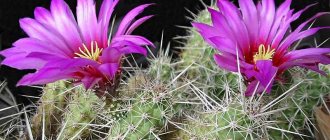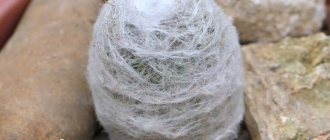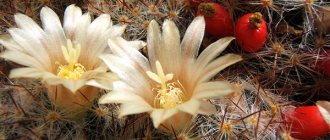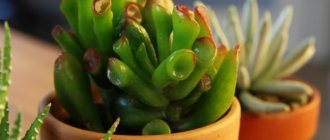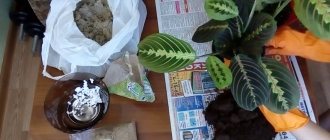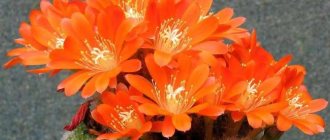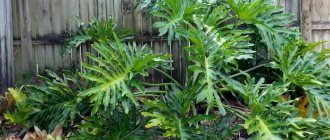general description
The trunk has a round, ribbed exterior . Since there is a similarity to a ball, the evaporation of moisture from the surface in this case is very small. And during the wet period, the ribs swell, helping the owner to absorb as much water as possible without cracking or bursting. Succulents are accustomed to living in poor, dry soil, and overwatering is extremely dangerous for them .
Flowering also depends on the amount of moisture; for desert dwellers this will not happen if the rains were not heavy or started late.
To protect from the sun, some have very thick skin , others spread out greatly to create shade for the main stem. There are also species that appear fluffy due to the large number of spines or hairs that completely cover the plant; there are no leaves .
Types of cacti: desert cacti, part 1
The cacti family is so diverse that scientists are developing new and new classifications designed to bring together all varieties of cacti. Still, the main division concerns the habitat, because the features of caring for the “thorn” directly depend on this. Types of cacti: desert cacti.
The homeland of cacti is South and North America, but now cacti grow on all continents of our planet, except Antarctica. Classification of forest cacti.
People from mountainous areas and arid deserts are accustomed to temperature changes.
- These varieties of cacti require full lighting and moderation in watering. The south-eastern, south-western and even southern side, where there is a lot of sun, is suitable for growing.
- They are usually not afraid of direct sun, but in partial shade they develop more slowly and do not bloom!
- The dormant period should take place in cool conditions, at a temperature of 10-12 degrees, with minimal watering and lighting. Dormant period for cacti: how to water the spines.
- With the arrival of spring, desert cacti are given plenty of water and then watered about once a month.
The names are clickable (not all of them yet). By clicking on the title, you will be taken to a detailed article on caring for this species.
Ariocarpus is a genus of cacti with low, flattened stems and stunning flowers. Some species have unusual stem colors, and almost all have “fluff” in the axils of the tubercles.
ariocarpus
Astrophytums are spherical cacti native to the southern United States. Their body is equipped with sparse ribs and small hairs along the stem. Some varieties resemble a “star”!
astrophytum
Azteciums are an unusual genus of cacti, formed by only two species. These individuals have characteristic transverse folds and faint spines.
Aztecium
Gymnocalyciums are numerous plants that share one feature - a smooth, hairless floral tube. Gymnocalyciums grow in well-drained soils and can look different: have large or small tubercles, spines of different colors and sizes.
Gymnocalycium
Gymnocalycium
Cleistocactus is a large genus that includes various species of desert cacti with cylindrical and lodging stems and dense, thin spines. Found in the mountains, they bloom abundantly!
cleistocactus
The genus Coryphantas unites the most beautiful cacti that differ in stem shape, flower color and spine characteristics. Different types of these cacti can be found in completely different climatic zones; they often grow in highlands and deserts.
Coryphantas
The genus Leuchtenbergia consists of one species. Externally, the cactus resembles an agave, which is why it received the nickname “agave cactus.” This appearance is given to it by elongated tubercles and antennae-like spines.
Leuchtenbergia
The genus Lophophora lives in Central Mexico. These cacti have almost no spines on their round stems. It is believed that the juice of lophophora can cause hallucinations, therefore the collection of these cacti in their natural habitats is strictly prohibited.
loffophora
Mammillaria is one of the most numerous cactus genera described on the website flowery-blog.ru. These cute "warts" grow in groups, usually have tubercles that form spirals, white delicate spines and beautiful flowers of different shades.
mammillaria
The Matucana cactus genus gets its name from a Peruvian province. These individuals are distinguished by their almost round shape; some types of cacti do not have spines at all, while others have sparse, curved spines.
matukana
Myrtillocacti bloom with barely noticeable flowers, so their trunk is of decorative value - smooth with sparse ribs and long dark spines.
myrtillocactus
Obregonia is a Mexican genus of cacti consisting of only one species. It has unusual tubercles, between which there are fluffy tassels. Obregonia also blooms unusually; its flower petals resemble daisies.
obregonia
If you have not found the required types of cacti among those listed, visit the second part of the classification.
Continued: desert cacti from “p” to “e” in the next article.
Support our site, share the link on social networks. Thank you!
Provided by SendPulse
Photo
We bring to your attention photos of desert cacti:
Tropical (forest) cacti
Tropical cacti are more warm and moisture-loving; they grow in diffused light in the special conditions of the humid evergreen forests of South America. Almost all representatives of forest cacti are epiphytes (grow on other plants), have long hanging stems, thin, soft, sometimes almost invisible, needles.
IN THE PHOTO: Schlumberger (or “Decembrist”)
A characteristic feature of epiphytic cacti is the ability to form aerial roots on the stems. Such roots serve to capture moisture from the air and attach to the bark of trees.
There are several groups of domestic tropical cacti:
- Whisker cacti with winter watering (cacti of the genus Heliocereus).
- Whisker cacti with a winter dormant period (Aporocactus, Hylocereus and Selenicereus).
- Leaf cacti blooming in spring and summer (Hatiora, Lepismium, Epiphyllum).
- Leaf cacti that bloom in autumn and winter (Schlumbergera and Rhipsalium).
Caring for Tropical Cacti
When growing tropical cacti, it is necessary to take into account some features that distinguish them from desert species - Otherwise, the principles of caring for desert and tropical species are the same:
- Tropical species grow in conditions of higher humidity and require frequent watering during the growth period without waterlogging the soil; such cacti can be frequently sprayed. Water only with warm water, settled or purified from impurities.
- The soil is selected with an acidic reaction, poor in organic matter. The soil must be loose and permeable to moisture.
- Cacti of the tropics are fed during the growing season. Only special mixtures intended for this group of plants are used.
- Replant plants as needed. To ensure tropical cacti bloom well, they are planted in small containers. The root collar is not buried; it is better to refrain from watering for several days after transplantation.
- Some whip cacti require a winter dormant period; at this time, reduce the temperature and stop watering. Plants that bloom in the autumn-winter period are dormant in late summer - early autumn. Certain species (genus Heliocereus) require watering in winter.
- Tropical cacti grow well only in diffused light; they do not tolerate direct sunlight. Some types of "leaf cacti" require partial shade.
- Forest cacti are quite thermophilic; the temperature should be above +12°C even in winter.
- The shoots of tropical cacti grow greatly; they need to be thinned out, removing old, damaged or improperly growing ones. Pruning is done in spring or early summer.
Cacti in America
Kingcap cactus.
Native to the Southwest, the kingcup cactus, also known as the burgundy bowl cactus, is a small species of cactus that occurs alone or in groups. Each rod is barrel-shaped and can reach 12 inches in height and 6 inches in thickness. The kingcup has long, straight spines as well as bright red flowers that take two or three days to open in the morning and which hummingbirds like to feed on. Kingcup fruits are also red and edible when ripe. Native people of the Southwest traditionally ate the kingcup cactus, burning its spines and crushing it for use in baking or candy making. Fruits were eaten raw.
cacti in nature
You can find the kingcup cactus in rocky crevices, coniferous forests, and desert grasslands, primarily in New Mexico, but also in Arizona, Colorado, Utah, Nevada, and California. To see beautiful flowers, visit from April to June to lower elevations and June to July to higher elevations.
types of cacti photos
Saguaro cactus.
An icon of the Southwest, the saguaro cactus is a tall, spiny plant found only in parts of the Sonoran Desert in Arizona. The lifespan of a saguaro is thought to be between 150 and 175 years, during which time each saguaro can reach between 40 and 60 feet in height. Saguaros develop branches starting when they are 50 to 70 years old, but the plant can take up to 100 years to grow an arm. Around the age of 35, they bloom large white flowers, usually at the top of the trunk or branches, which attract many pollinators.
In the past, the Hohokam people of the Tucson area used the ribs of dead saguaros to build their homes. The Tohono-'odham, descendants of the Hohokam people, consider the plant sacred and, like their ancestors, use the fruit (red, grown in the summer) to make wine, jellies, and candy.
Visitors to the Sonoran Desert can witness the beautiful flowers that open at night and close during the day from late April to early June, and see the many birds that make the saguaro their home—the golden avocet and the Gila woodpecker build nests inside the cactus. Bald eagles have also been spotted nesting on saguaros.
types of cacti photos
Organ pipe.
In the United States, organ pipe cacti are found exclusively in the Organ Pipe Cactus National Monument in Arizona, where they grow on south-facing slopes to survive winter frosts. They gather in large groups, can reach 10-20 feet in height, and resemble the pipes of a church organ. Like the saguaro, the organ pipe cactus can live a very long life (more than 150 years) and bloom white flowers at around 35 years of age. The flowers are visible at night until mid-morning in May and June each year, after which they produce red fruits. The fruits can be eaten when they are ripe.
cacti in nature
Reed cholla cactus.
The cholla reed cactus, also called the cholla tree, is native to the Southwest, specifically Arizona, New Mexico, Colorado, Texas, Oklahoma and Kansas. One of seven species of cholla, the reed cholla grows into a bush up to 8 feet tall and produces bright purple and purple flowers in May and June and conical yellow fruits in the summer.
cactus in America
Like all cholla cacti, reed cacti are composed of cylindrical segments attached to each other, which separate upon contact with an animal. The spines are known to be incredibly painful when they come into contact with the skin and are difficult to remove (a fine-tooth comb must be used). Local indigenous people used the fruit to eat it raw, dried, stewed, and even ground into flour. When the plant dies, its intricately patterned wood is used to make pieces of furniture or walking sticks, hence its common name.
The reed cholla is the most common cholla cactus in New Mexico and can be easily seen at White Sands National Park and Petroglyph National Monument.
Saguaro National Park
Unique giant plants grow only in the Sonoran Desert, which stretches from Arizona to Mexico. The state protects these unusual forests, where dense thorns are visible on the trees instead of leaves.
Since 1933, the desert territory has been a nature protection zone. Even when constructing roads or any structures, they take into account whether the construction will damage the natural attractions of the United States.
In 1994, a National Park appeared, the basis of which is the territory of the Green Desert. This is what Sonora is called. This desert is radically different from other desert areas.
Relief
In fact, sand occupies only a quarter of the Sahara, and the rest of the territory is occupied by stone structures and mountains of volcanic origin. In general, we can distinguish the following objects in the desert:
p, blockquote 46,0,0,0,0 –>
- Western Sahara - plains, mountains and lowlands;
- Ahaggar - highland;
- Tibesti - plateau;
- Tenere – sandy expanses;
- Libyan Desert;
- Air - plateau;
- Talaq – desert;
- Ennedi – plateau;
- Algerian desert;
- Adrar-Iforas - plateau;
- Arabian Desert;
- El Hamra;
- Nubian Desert.
The largest accumulations of sand are in such sandy seas as Igidi and the Great Eastern Erg, Tenenre and Idehan-Marzuk, Shesh and Aubari, the Great Western Erg and Erg Chebbi. There are also dunes and dunes of various shapes. In some places there is the phenomenon of moving and also singing sands.
p, blockquote 47,0,0,0,0 –>
Desert terrain
p, blockquote 48,0,0,0,0 –>
If we talk in more detail about the relief, sands and the origin of the desert, scientists claim that the Sahara was previously an ocean floor. There is even a White Desert here, in which white rocks are the remains of various microorganisms of antiquity, and during excavations paleontologists find skeletons of various animals that lived millions of years ago. Now sands cover some parts of the desert, and their depth in some places reaches 200 meters. Sand is constantly transported by winds, forming new landforms. Under the dunes and sand dunes there are deposits of various rocks and minerals. When people discovered oil and natural gas deposits, they began to extract them here, although it is more difficult than in other places on the planet.
p, blockquote 49,0,0,0,0 –>
Interesting facts about the Sahara
Among the interesting facts about the Sahara, it should be noted that it is not completely deserted. More than 500 species of flora and several hundred species of fauna are found here. The diversity of flora and fauna forms a special ecosystem on the planet.
p, blockquote 53,0,0,0,0 –> p, blockquote 54,0,0,0,1 –>
In the bowels of the earth, beneath the sandy seas of the desert, there are springs of artesian water. One of the interesting phenomena is that the territory of the Sahara is changing all the time. Satellite images show that the desert area is either increasing or decreasing. If the Sahara was previously a savannah, now it is a desert, it is very interesting what several thousand years will do to it and what this ecosystem will turn into.
- Author: Maria Sukhorukikh
Rate this article:
- 5
- 4
- 3
- 2
- 1
(0 votes, average: 0 out of 5)
Share with your friends!
Climatic conditions in the desert
The Sahara has an extra-arid climate, that is, dry and hot tropical, but in the far north it is subtropical. The desert recorded a maximum temperature on the planet of +58 degrees Celsius. As for precipitation, it is absent here for several years, and when it falls, it does not have time to reach the ground. A common phenomenon in the desert is wind that raises dust storms. Wind speed can reach 50 meters per second.
p, blockquote 7,0,0,0,0 –>
There are strong differences in daily temperatures: if during the day the heat is over +30 degrees, which makes it impossible to breathe or move, then at night it becomes cool and the temperature drops to 0. Even the hardest rocks cannot withstand these fluctuations, which crack and turn into sand.
p, blockquote 8,0,0,0,0 –>
In the north of the desert there is the Atlas mountain range, which prevents Mediterranean air masses from entering the Sahara. Moist atmospheric masses from the Gulf of Guinea move from the south. The desert climate affects neighboring climatic zones.
p, blockquote 9,0,0,0,0 –>
Reviews
Poster House of Corleone Cactus in the desert 07-0323-21x30, 21x30 cm and other products in this category are available in the catalog of the Leroy Merlin online store in Moscow at low prices. Read the detailed characteristics and description, as well as reviews of this product, to make the right choice and order the product online.
Buy products such as Poster House Corleone Cactus in the desert 07-0323-21x30, 21x30 cm, in the Leroy Merlin online store, having first checked their availability. You can receive the goods in Moscow in a way convenient for you; to do this, read the information about delivery and pickup.
You can always place an order and pay for it online on the official website of Leroy Merlin in Russia. For residents of the Moscow region, we not only have low prices for products such as “Poster House Corleone Cactus in the desert 07-0323-21x30, 21x30 cm”, but also fast delivery to cities such as Moscow, Balashikha, Podolsk, Khimki, Korolev , Mytishchi, Lyubertsy, Krasnogorsk, Elektrostal, Kolomna, Odintsovo, Domodedovo, Serpukhov, Shchelkovo, Orekhovo-Zuevo, Ramenskoye, Dolgoprudny, Pushkino, Reutov, Sergiev Posad, Voskresensk, Lobnya, Ivanteevka, Dubna, Yegoryevsk, Chekhov, Dmitrov, Vidnoye, Stupino, Pavlovsky Posad, Naro-Fominsk, Fryazino, Lytkarino, Dzerzhinsky, Solnechnogorsk, Istra and Zhukovsky.
Why do flowers survive in such conditions and how do they grow?
Thorns are of great importance in terms of the survival of cacti in the desert. They are the ones who prevent animals from eating this plant. In addition to protection, spines and hairs collect moisture. They are able to absorb drops of water that settle as dew. For most species of desert cacti, this is the only way to obtain moisture in dry areas.
For a long time, desert cacti adorned these lands exclusively. However, today they can often be found at home among lovers of these plants. This is proof that desert cacti species adapt well to different living conditions .
If you find an error, please select a piece of text and press Ctrl+Enter.
Natural habitat
Mexico is considered the birthplace of cacti . Despite the harsh climate, heat and lack of moisture, cacti have adapted to living in the desert, becoming one of the hardiest plants.
Deserts are not only endless sandy fields with rare oases. There are many types of deserts, and each differs in soil, temperature, and amount of precipitation.
The best habitat for cacti is the rocky deserts of America, the hot steppes and highlands of Mexico. The soils there are rich in minerals and other nutrients, making it easier for cacti to tolerate heat and lack of moisture.
Different types of cacti have adapted to the constant heat in their own way. To protect themselves from direct sunlight, some cover themselves with thin white spines. Others shade the main stem with side shoots, so many cacti look like strange and very beautiful multi-tiered structures.
Cacti store water in their thick leaves or stems and gradually distribute it throughout the plant. Under natural conditions, they have to wait months or years for the water reserve to be replenished. The salvation for cacti is dew and night fogs, which give them at least a little moisture. Therefore, watering for cacti can be done very rarely.
Excess moisture for a cactus is certain death. It is better to completely deprive it of watering, as this is more consistent with its natural environment.
Step-by-Step Instructions for Drawing Cacti
1. Start outlining your cactus. Draw a long, curved line. Notice how the line doubles on itself to form the branch or arm of the cactus.
2. Continue outlining the cactus. Draw another long, curved line, doubling it again to form the second arm of the cactus.
3. Give your cactus soil to stand on. Draw several slightly curved horizontal lines of varying lengths to indicate the ground underneath the cactus.
4. Start outlining the second cactus in the background. Use a long, curved line, allowing it to double in size and form the cactus arm.
OTHER EASY GUIDES:
Asceticism and beauty
Desert cacti are extremely unpretentious and very profitable plants to grow at home. Minimum effort, no difficulties and maximum pleasure from contemplating beautiful cactus carcasses.
Source: kustroz.ru
A message about a cactus will help you compose a text description about a cactus, a perennial prickly plant. The 2nd grade report on the cactus can be supplemented with interesting facts.
Message about the cactus
Cacti belong to the Cactaceae family, which includes more than 2800 species. There are 3 subfamilies: Opuntiaceae, Cereusaceae and Peresceaceae.
Where do cacti grow?
Some plants grow in Europe, in the Mediterranean regions, in the tropics of Africa, and on the island of Madagascar. The cactus can also be found in Australia and on the southern coast of Crimea. They are bred as ornamental plants in open ground, in greenhouses and rooms.
Cactus: description of appearance
Cacti are perennial plants that have succulent, thick and fleshy stems. They are covered with spines, bristles or hairs. Most types of cactus have fruits that are berry-shaped, fleshy, and some are even edible. Due to the fact that the plants primarily grow in the desert, they are devoid of foliage. The leaves turned into thorns, and water began to accumulate in the massive thick stem. Speaking of thorns. They have different shapes - flat, round, straight or hooked, fluffy or smooth. Although some species of the family have leaves. So, pereskia, which grows in South America, Mexico, and India, has a woody stem, leaves and... spines. Another plant, prickly pear, has small leaves 2-5 mm long. Outwardly, they resemble an awl and are very juicy. The leaves sprout in the spring and after a short time dry out and fall off.
Cacti accumulate even a small part of the water that gets into the soil. Young shoots can pick up moisture even from the air. Then they fall off and take root. The largest cacti can store up to 2000 liters of water. And so that less moisture evaporates, the plants are covered with a thick green skin, and on top of it is a hair or layer of wax.
Cacti are actively used in medicine. They are used to make drugs for the treatment of cardiovascular diseases and rheumatism.
Interesting facts about cacti:
- Christopher Columbus in his notes mentions the melon that the aborigines he met ate. But, in fact, they were cacti.
- Cacti are raw materials for the production of shampoos, sweets, alcoholic beverages, soap, vitamins and other things. Waste from production is fed to domestic animals.
- Farmers in Mexico feed prickly pears to their cows, which have been previously cleared of thorns, so that the animals produce more milk.
- In Bolivia and Paraguay, baked Weingartia/Neowerdermannia cacti are a real delicacy. In Mexico, candied pieces of the Melocactus oaxacensis cactus are also a local delicacy.
- In the past, sterilized cactus needles were used by doctors in Latin America to stitch wounds.
- The spines of the plant ionize the air.
We hope that the essay about the cactus helped you learn a lot of useful information. You can add a brief message about the cactus using the comment form below.
Source: kratkoe.com
Useful articles on ecology:
A few final tips
- Cacti do not like sudden changes in conditions; plants are accustomed to any changes in the regime gradually. Some cacti react negatively even to moving the pot to another location.
- The most common cause of death of cacti is rotting of roots and shoots; to avoid this, you should follow the rules of watering and replanting plants.
- When caring for cacti, you need to focus on the type of specific plant and the natural conditions of its growth.
- Most cacti require a period of rest, when the plant does not need to be watered or fed, but should be kept at a low temperature.
- Almost all cacti bloom better in a cramped pot; too much soil has a negative effect on the development of the plant.
- If buds appear on the cactus, the plant cannot be rearranged, rotated, changed the frequency of watering, fed or replanted. Otherwise, the buds will be dropped or turn into vegetative shoots.
